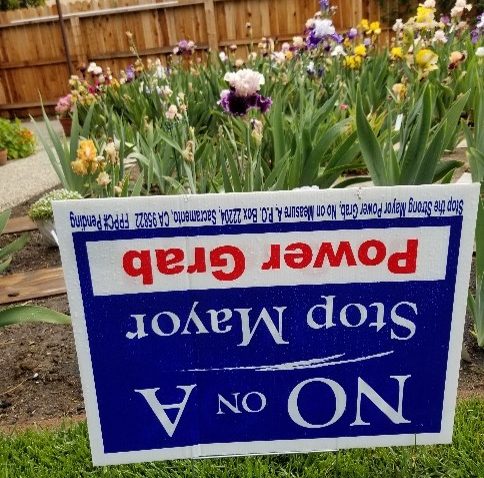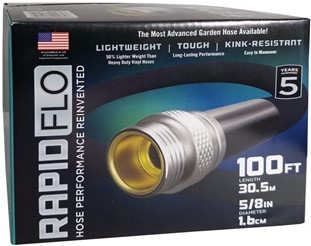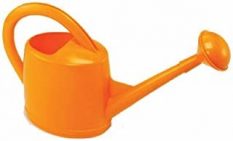
by Stan Logan | May 21, 2021 | Garden tools, Irrigation
I recently had a newly cultivated area that I wanted to let dry out until planting. I used 2 political signs to ward off the spray from 2 sprinklers and they really worked well. By cutting off all but 6 inches from the supporting wire of the sign, you can poke it into the ground and move the shield wherever you want. The sign is made of corrugated plastic so it is impervious to water. On the other hand, you might want to shield certain plants from harsh sun rays. When not in use, these flat shields store efficiently.
As you know these signs are readily available when political issue are made public. You can either wait until issues are settled, or simply pick up the signs when they don’t agree with your viewpoint. ( My editor says I can’t say that.)
Stan, The Blog Man

Repurposed political signs as garden shields
by Stan Logan | Apr 16, 2021 | Irrigation
OK hosers! This may be the hose you’ve been dreaming about. The Flexilla is a 5/8 inch, heavy duty, lightweight hose that is kink proof under pressure. I’m sure if you gabbed it firmly and gave it a good twist and pull, you could probably prove me wrong. You wouldn’t do that would you? Two of my closest gardening friends have this hose and swear by it. I ordered a 25 foot length and can join their chorus. Light weight and doesn’t kink—it’s a miracle. Perhaps its most valuable feature is that being really flexible, it lays flat which means you are less likely to trip over it. Its bright green color also helps too. It’s lead free drinking water safe to boot.
You can buy this hose in different lengths on Amazon, or find it in various local stores. If you look on Amazon you will see that it has had over 30,000 reviews! It’s a good time to be a hoser!
Happy hosing,
Stan, The Tool Man

by Stan Logan | Apr 7, 2021 | Garden tools, Irrigation
I’ve taken a chance here. While walking the isle at Costco, I spotted a pallet of boxes of garden hoses—RAPIDFLO 100 ft length, 5/8 inch diameter, lightweight, tough, kink-resistant. You see, LaVille has been wrestling with a rubber hose that has become stiffer with age. (What’s new?) She has had to drag it through the main iris garden and then wind it back up on the hose reel when done. So I uncoiled the old, stiff hose off the reel. Actually it now remains permanently coiled along the side yard. I then attached this new hose to the spool and turned on the pressure. I could see that LaVille at the far side of the yard was now watering with less than expected flow. Not only did the 100 foot length impede the flow, but the 5/8 inch hose itself was perhaps still somewhat flattened. Maybe continued use will expand it—probably not. Perhaps the company should change it’s name to SLOFLO. But LaVille says that the gentle spray was actually desirable. Anyway, when LaVille was finished watering, I had her close the spray wand valve to keep the hose turgid, and wound the hose up on the reel. You don’t want a flattened hose on the reel. That would really limit flow. The winding task was truly easy to do because the hose is really lightweight.
So, do I recommend this hose? The jury is still out at our house. I would say that if you are tired woman handling (Is that sexist?) an old, heavy hose around, this may be the hose for you. You can easily coil the hose in a large pot if you don’t have a reel. I am going to assume that this hose design is less likely to leak as the expandable hoses tend to do. Keep in mind that this is 100 feet of hose. It seemed a little long for my yard that is only 80 feet wide. As of 3/20/21, this hose if available at Costco for $39.99. If you miss it there, Amazon has it for $55 (Yikes!).
Happly hosing,
Stan, The Tool Man

RapidFlo Hose
by Stan Logan | Oct 30, 2020 | Irrigation
I have always been cheap. My wife has been working on me to change this attitude for 50 years now, and I must admit that she has largely been successful. I still, however, really resist throwing anything away. It’s not that I am a hoarder, I just find extreme pleasure on finding a use for an object after I have saved it for years. I have junk drawers that are a challenge to close. This cheapness applies to tools as well. For instance, I am still using the wheelbarrow and sawhorses my dad (who was a contractor) gave me nearly 50 years ago—and they were old and beat up then!
Anyway, this impulsion to save stuff has resulted for instance in collection of old soaker hoses and pieces of soaker hoses that fill a garbage can. I’ve now decided that the garbage can is the best destination for this accumulation. You see, our main iris garden was watered by a variety of soaker hoses—different sizes and different ages. The result was very uneven watering—some parts were completely dry, some parts over watered, and there were frequent squirts here and there. LaVille would have to drag a hose through the garden and water everything every week. After listening to several complaints (she is careful not to nag), I finally decided to bite the bullet and buy new soaker hose. I was looking for ½ inch hose everywhere, but only found 3/8”. Interesting enough, I found the same brand at every store. For instance, the 50 foot SoakerPro by Element was about $17 at Home Depot. However, the same hose was $5.72 at the Lowes in West Sacramento. I jumped on that one! In fact, I bought two.
The hoses were easy to install. I first unrolled the coils and twisted it to take out all of the loops. Then as I dragged it through the garden I pinned it using “U” shaped wires made from coat hangers that I had been saving. When I turned on the water, I couldn’t believe how well the water was distributed. I bet this system could also be used to water lines of potted plants if they were, say, all one-gallon pots.
So, if you find that your soaker hose is squirting rather than dripping, head for West Sacramento. Don’t be cheap and take the hose out in the street and run over it with the car—which is the old, recommended treatment for soaker hoses that get clogged by minerals. You will love how much better a new hose works.
Happy dripping!
Stan, The Tool Man
by Stan Logan | Jul 14, 2020 | Garden tools, Irrigation
I think each of us battles with hoses and faucets that drip. When a faucet drips, it’s generally a leak that occurs at the base of the handle stem. You will probably notice that the handle is really easy to turn. What is supposed to seal the handle stem within the faucet is what is called a pressure washer. Over time these tend to shrink so that they no longer seal well against the stem. What you need to do is get an adjustable wrench and tighten the large nut at the base of the handle stem. This nut is probably “frozen” so you may have to use considerable force to tighten it. Hold the faucet firmly with your other hand to prevent damage elsewhere. Tighten the nut until the faucet handle is still easy to turn.
Many hose leaks occur where the hose attaches to the faucet. If you replace the rubber or plastic washer in the female fitting, your leak will generally be solved. Grab the old washer with pliers—a needle nose works best–and pull it out. Insert a new washer. If the hose end still leaks, try tightening it further. A channel lock wrench works well for this. If the leak continues, you may have to replace the female hose end. Washers and replacement hose ends are common in nurseries and hardware stores. Make sure though that you buy the proper size end replacement for your hose size—3/4”, 5/8”, or ½”. You may also choose to buy a new hose particularly if the old one is constantly kinking. Here I would advise you that you get what you pay for. Make sure that you are getting the right length to fit your needs—too much hose can be a pain also.
Now that I think of it, hose leaks frequently occur at the other end where you attach a sprayer of some kind. Here, again, the problem is generally the washer. If replacing the washer doesn’t help, check the end of the male hose fitting. If the surface that meets the washer is not smooth, you will need to flatten the end surface with a file. If the male hose end cannot be repaired, replace it noting the advice a gave you above. Of course, if the leak is within the sprayer attachment, it is time for it to go.
Stan, The Blog Man
P.S. LaVille, my editor, mentioned that the biggest problem with leaks is that your shoes get wet and can sometimes be ruined. So this is a very serious matter!

by Stan Logan | May 20, 2020 | Container plants, Irrigation
Every now and then I get a good idea. I think the last time was June 14, 2005. This new idea cannot be claimed as my own, but then at least the plan to pass it on to you is my own.
I was watching an episode of Gardeners’ World on Amazon Prime when they had a segment about a lady who had a garden with 1,259 pots—and I don’t mean dinky ones. These were all different and some were quite large. Sounds crazy, huh? Apparently she inherited this pot fetish from her mother who had 700 pots. Now, this is not the significant part. What is—is that she watered all of these by hand using a watering can that she dipped into 21 different dipping containers that were spread throughout the garden. These 21 reservoirs are kept filled by a drip system. Now maybe you don’t mind dragging a hose around the garden, particularly if you have own of those expandable hoses that is light weight. But consider this: What if you had a large garbage can that was in a convenient place in the garden that you could fill once in a while and add a light dose of fertilizer. Now besides not having a hose to mess which each time you water, you are regularly giving your plants extra nutrients. Good idea?
We have been using this system for a month now. I use a pump and long hose to fill two 55 gallon barrels—one on each side of the yard. The water comes from our koi pond so it already has fertilizer added. The plants absolutely love it. LaVille uses a watering can that has a handle that runs fore and aft, so she can water with one hand with the other one free to test the soil moisture of each pot. She only has one good arm left anyway.
She frequently loses track of the watering can, so I tried buying another. I finally found the right style on Amazon Prime. (Dramm 7 Liter Watering Can 12433, $38.22) There are many models that are far less expensive, but they all have bales that are mounted crosswise.

Watering Can
So even if you don’t have a pot fetish, you may want to try out this new idea. LaVille would never admit to a fetish, but with the added SPPC plants, she does have over 250 outside containers and 50 inside.
Stan, The Tool Man




